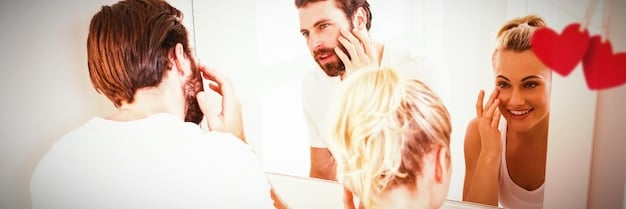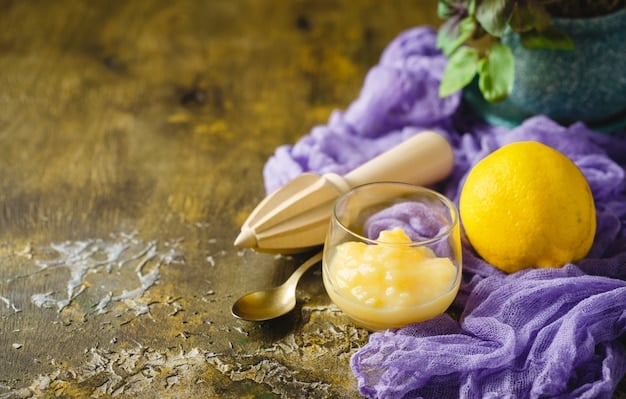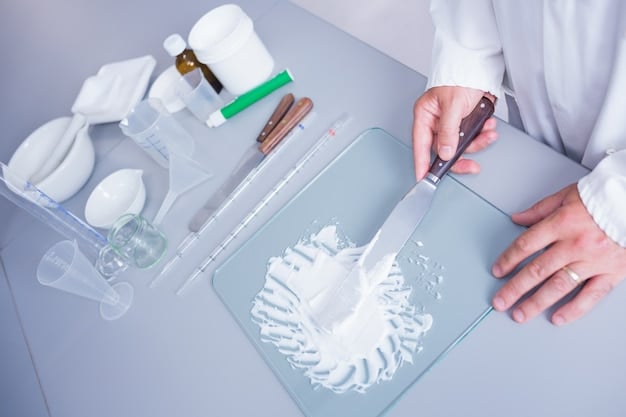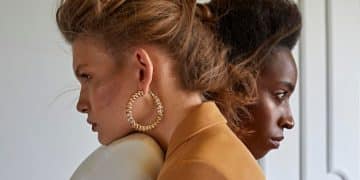Viral Beauty Hacks Debunked: Fact vs. Fiction in 2025

Viral beauty hacks continue to flood social media, but in 2025, it’s crucial to distinguish between effective techniques and potentially harmful trends. This article debunks popular hacks, providing insights on their safety and effectiveness based on current dermatological knowledge and scientific evidence.
The world of beauty is constantly evolving, especially with the rise of viral trends. But how many of these online hacks are actually worth trying? Let’s dive into the truth behind some of the most popular, separating fact from fiction and keeping your skin safe in 2025. Viral Beauty Hacks Debunked: Separating Fact from Fiction in 2025 is essential knowledge for every beauty enthusiast!
Understanding the Rise of Viral Beauty Hacks
Social media platforms have become breeding grounds for beauty trends, with users sharing tips and tricks promising remarkable results. From skincare remedies to makeup application techniques, these hacks often gain viral status, attracting millions of views and enthusiastic followers. However, it’s essential to understand where these trends originate and whether they are backed by scientific evidence.
The allure of viral beauty hacks lies in their accessibility and affordability. Many of these tricks utilize everyday household items, offering a DIY approach to beauty that appeals to budget-conscious consumers. The promise of quick, visible results further fuels their popularity, as users seek instant gratification in their beauty routines.
The Power of Social Media
Platforms like TikTok, Instagram, and YouTube have revolutionized the way beauty information is shared. Beauty influencers and content creators play a significant role in popularizing these hacks, often leveraging their large followings to promote new trends. The visual nature of these platforms makes it easy to demonstrate techniques and showcase before-and-after results.
DIY Beauty Culture
The DIY beauty movement emphasizes personalization and creativity, encouraging individuals to experiment with different ingredients and techniques. This culture fosters a sense of empowerment, as users take control of their beauty routines and tailor them to their specific needs. However, it also raises questions about the safety and efficacy of unverified methods.
- Verify the source: Look for dermatologists or skincare professionals.
- Check the ingredients: Ensure they are safe for your skin type.
- Read reviews: See what others are saying about the hack.
Ultimately, the rise of viral beauty hacks reflects a broader trend towards democratization in the beauty industry. Consumers are no longer solely reliant on traditional brands and experts; they are actively seeking alternative solutions and sharing their experiences with a global audience. This shift presents both opportunities and challenges, requiring a critical approach to evaluating beauty advice online.
Common Viral Beauty Hacks: What’s the Verdict?
Many viral beauty hacks circulate online, but some are harmless and effective, while others can be damaging. This section examines some of the most common hacks, assessing their potential risks and benefits based on expert opinions and scientific research. By understanding the true impact of these trends, consumers can make informed decisions about their beauty routines.
It’s crucial to approach viral beauty hacks with a healthy dose of skepticism. Just because something is popular doesn’t mean it’s safe or effective. Many of these hacks lack scientific backing and can even cause adverse reactions, especially for those with sensitive skin or pre-existing conditions.

Lemon Juice for Skin Brightening
The claim: Lemon juice can brighten skin, fade dark spots, and reduce acne due to its high concentration of vitamin C and citric acid.
The verdict: While vitamin C is beneficial for the skin, applying lemon juice directly can be harmful. Its high acidity can cause irritation, sunburn, and even chemical burns. Dermatologists recommend using professionally formulated vitamin C serums instead.
Baking Soda as a Face Scrub
The claim: Baking soda exfoliates the skin, unclogs pores, and reduces blackheads.
The verdict: Baking soda has a pH level that is too high for the skin, disrupting the natural acid mantle and leading to dryness, irritation, and increased sensitivity. Gentle physical or chemical exfoliants are safer alternatives.
- Avoid using harsh acids directly on the skin.
- Opt for products with balanced pH levels.
- Consult with a dermatologist for personalized advice.
Proper analysis of common viral beauty hacks reveals that many are not only ineffective but also potentially harmful. By relying on scientific evidence and expert recommendations, consumers can avoid these pitfalls and maintain healthy, radiant skin.
The Science Behind Skincare: Why Professionals Know Best
Understanding the scientific principles behind skincare is essential for making informed decisions about beauty routines. Dermatologists and cosmetic scientists possess in-depth knowledge of skin physiology, ingredient interactions, and the potential effects of different treatments. Their expertise is invaluable in distinguishing between safe, effective practices and harmful trends.
Skincare is not a one-size-fits-all solution. Factors such as skin type, underlying conditions, and environmental stressors can all influence how the skin reacts to different products and treatments. Professionals can assess these individual needs and recommend personalized regimens that address specific concerns.
The Importance of Formulation
Cosmetic scientists carefully formulate skincare products to ensure that ingredients are delivered effectively and safely. They consider factors such as pH balance, stability, and penetration to optimize the performance of each product.
Understanding Ingredient Interactions
Certain ingredients can interact with each other, either enhancing or diminishing their effects. Professionals understand these interactions and can advise on which ingredients to combine and which to avoid. For example, using exfoliating acids with retinoids can cause excessive irritation and should be done with caution.

- Seek advice from certified dermatologists and estheticians.
- Prioritize products with clinically proven ingredients.
- Avoid mixing multiple active ingredients without professional guidance.
Relying on professional expertise ensures that skincare routines are grounded in scientific evidence rather than fleeting trends. This approach leads to healthier, more effective results, minimizing the risk of adverse reactions and long-term damage.
Safe Alternatives to Risky Beauty Hacks
Instead of relying on potentially harmful viral beauty hacks, consumers can explore safer, more effective alternatives that deliver real results. These alternatives are often backed by scientific research and formulated with ingredients known for their beneficial properties. By making informed choices, individuals can achieve their beauty goals without compromising their skin’s health.
Many professional skincare products offer targeted solutions for common concerns such as acne, hyperpigmentation, and aging. These products are rigorously tested and formulated to deliver optimal results while minimizing the risk of irritation or adverse reactions. Investing in quality skincare is a worthwhile investment in long-term skin health.
Gentle Exfoliation
Instead of using harsh scrubs like baking soda, opt for gentle chemical exfoliants such as AHAs (alpha hydroxy acids) or BHAs (beta hydroxy acids). These ingredients promote cell turnover and unclog pores without causing physical damage to the skin.
Hydrating Masks
For dry or dehydrated skin, hydrating masks containing humectants like hyaluronic acid and glycerin can provide a boost of moisture. These masks help to plump the skin, reduce the appearance of fine lines, and improve overall radiance.
- Choose products with clinically proven ingredients.
- Read reviews and seek recommendations from trusted sources.
- Patch-test new products to check for allergic reactions.
Safe alternatives to risky beauty hacks empower consumers to take care of their skin in a responsible and effective manner. By prioritizing evidence-based practices and professional guidance, individuals can achieve their beauty goals while maintaining healthy, radiant skin.
Navigating Beauty Trends in 2025: A Critical Approach
As beauty trends continue to evolve in 2025, it’s more important than ever to adopt a critical approach to evaluating the information circulating online. Social media can be a valuable source of inspiration and information, but it’s also rife with misinformation and potentially harmful advice. By developing critical thinking skills, consumers can navigate the beauty landscape with confidence and make informed decisions about their skincare routines.
One of the best ways to stay informed is to follow reputable dermatologists and skincare experts on social media. These professionals often debunk common myths and provide evidence-based recommendations that consumers can trust. Engaging with these experts can help to filter out the noise and focus on what truly works.
Fact-Checking and Research
Before trying any viral beauty hack, take the time to research its origins and potential risks. Look for scientific studies or expert opinions that support or refute the claims being made. Websites such as PubMed and Google Scholar can be valuable resources for finding reliable information.
Understanding Your Skin Type
Not all beauty trends are suitable for every skin type. Consider your individual needs and sensitivities before experimenting with new products or techniques. If you have sensitive skin or pre-existing conditions, consult with a dermatologist before making significant changes to your routine.
- Follow reputable dermatologists and skincare experts.
- Research the origins and potential risks of viral trends.
- Consider your individual skin type and sensitivities.
A critical approach to beauty trends in 2025 empowers consumers to make informed decisions that align with their individual needs and values. By combining online resources with professional guidance, individuals can cultivate healthy, effective skincare routines that promote long-term skin health.
The Future of Beauty: Sustainable and Science-Backed Solutions
The beauty industry is increasingly focused on sustainability and science-backed solutions, reflecting a broader trend towards responsible consumption and environmental awareness. Consumers are demanding products that are not only effective but also ethically sourced and environmentally friendly. This shift is driving innovation and transforming the way beauty products are formulated, packaged, and marketed.
Sustainable beauty practices include using eco-friendly packaging, sourcing ingredients from renewable resources, and minimizing waste throughout the production process. Brands that prioritize sustainability are often transparent about their practices and committed to reducing their environmental impact.
Clean Beauty Formulations
Clean beauty focuses on formulating products without potentially harmful ingredients such as parabens, sulfates, and phthalates. These formulations prioritize safety and transparency, ensuring that consumers can make informed choices about what they put on their skin.
Personalized Skincare
Advances in technology are enabling personalized skincare solutions tailored to individual needs. DNA testing, skin analysis tools, and AI-powered apps can provide insights into skin characteristics and recommend customized product regimens.
- Support brands committed to sustainable practices.
- Choose products with clean, transparent formulations.
- Explore personalized skincare solutions tailored to your needs.
The future of beauty lies in sustainable and science-backed solutions that promote both individual well-being and environmental responsibility. By embracing these trends, consumers can contribute to a more ethical and sustainable beauty industry.
| Key Point | Brief Description |
|---|---|
| 🧐 Verify Sources | Check credentials of beauty advice sources. |
| 🧪 Scientific Backing | Ensure hacks have scientific research supporting them. |
| 🍋 Avoid Harsh DIYs | Skip lemon, baking soda, and other irritating ingredients. |
| 🌿 Safe Alternatives | Opt for gentle, science-backed skincare products. |
FAQ: Understanding Viral Beauty Hacks
▼
Not all viral beauty hacks are dangerous, but it’s crucial to approach them with caution. Some hacks may be ineffective but harmless, while others can cause irritation or damage to your skin. Always research and verify the safety of a hack before trying it.
▼
Look for advice from reputable dermatologists and skincare experts. Check if the hack has any scientific backing or if there are any potential risks associated with the ingredients or techniques involved. Also, consider your skin type and any sensitivities you may have.
▼
Ingredients such as lemon juice, baking soda, and undiluted essential oils can be harmful when applied directly to the skin. These ingredients can cause irritation, dryness, and even chemical burns. It’s best to avoid them in DIY beauty hacks.
▼
In most cases, professional skincare products are safer and more effective than DIY hacks. These products are formulated with carefully selected ingredients and undergo rigorous testing to ensure their safety and efficacy. They are also designed to deliver targeted results without causing harm to the skin.
▼
Reliable beauty advice can be found on the websites of reputable dermatologists and skincare professionals, as well as in peer-reviewed scientific journals. You can also follow trusted beauty influencers who prioritize evidence-based recommendations and transparency.
Conclusion
In 2025, the beauty landscape is a mix of innovation and viral trends. It’s essential to approach beauty hacks with a discerning eye, prioritizing scientific evidence and professional advice over fleeting online fads. By doing so, you can ensure that your beauty routine enhances, rather than compromises, your skin’s health.





